Stargazing

|
Down the Milky Way |

|
- You can see the Milky Way on any clear fall night, but under a dark sky,
on especially clear nights, the Milky Way glows like a neon light,
from north horizon to south horizon, and seems bright enough to light
your path. Most people recognize the Milky Way as a band of light across
the night sky, but what is that band of light - where does it come from?
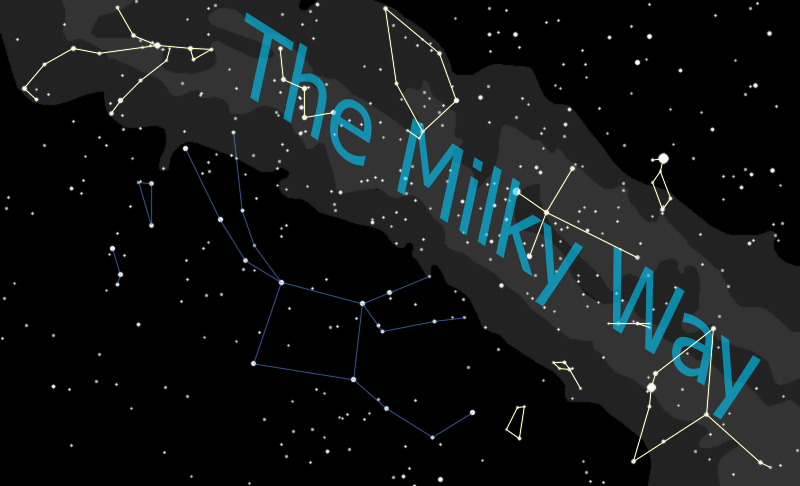
- Well it's a bit like looking at a gravel road. Close to you, you can see
individual stones, while off in the distance the road merges into a uniform
gray. When you look at the Milky Way you are looking at the disk of our
galaxy from the inside - the nearby stars you can see individually (most
are less than 1,000 light years away), the distant stars merge into a hazy
glow. So when you see that band across the sky you are really looking way
off into the distance, into the "billions and billions" of stars that make
up the disk of our galaxy.

You'll see a similar phenomenon later when you look at the Wild Duck Cluster in Aquila. Through binoculars you will see it as a hazy patch. When you see it through a telescope - that is, closer up - you can pick out individual stars. The better the telescope, the 'closer' you can get to the cluster, the more stars you can see.
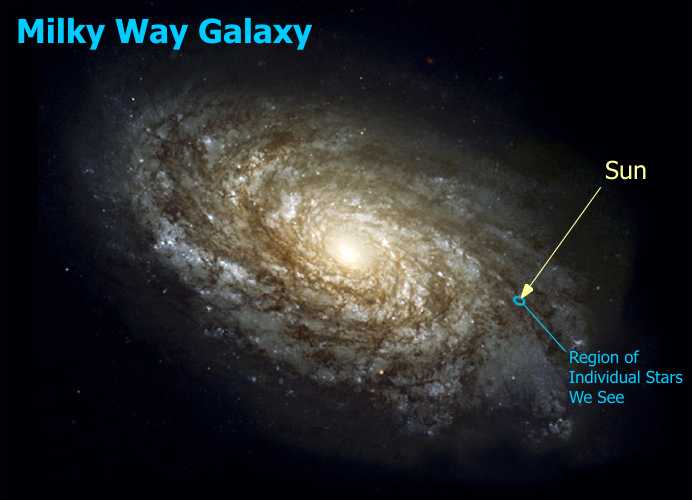
- Now as you look up at the Milky Way you can't help but notice a really bright star just off the Northwest edge of the band. That star is the renowned Vega, the home of the aliens in the movie Contact. Vega is a zero magnitude star, about 25 light years away, 3 times the mass of the sun, and about 50 times as bright as the sun. Imagine having 50 suns in our sky. If Vega was our sun we'd be cooked.
- Vega is part of the constellation Lyra the Lyre. {Trace out Lyra.} It is
easily recognizable as a parallelogram of four stars right next to the very
bright Vega. This constellation represents a lyre, or harp, with Vega at
the top of the lyre as one of the handles. (The other handle must have
broken off.)

- The star next to Vega to the northeast (or up and to the left), ε (epsilon) Lyrae, is actually a double star when you look at it in binoculars. However, if we can get a good telescope on that star you will see that each of the stars in the double is itself a double - a very cool sight to see. These four stars form a set that is a true double-double star, formed from the same nebula, which was spinning so fast it first spun apart into two protostars. They in turn each spun themselves apart into two stars.
- The parallelogram star to the southwest, the lower right-hand corner of the
lyre, is β (beta) Lyrae, which is variable star -
it is usually about as bright as the southeast, or lower left-hand corner
star γ (gamma) Lyrae. Every 6½ days the star dims
to half its brightness. Any ideas why this might happen? This star is an
"eclipsing binary" - two stars orbiting each other every 13 days. Every
half orbit one of the stars passes in front of the other and instead of seeing
two stars we only see one - the star drops to half its brightness, which is
about a magnitude. So take a look at β Lyrae - do
you think it's eclipsing right now?
- Now if we can get a telescope aimed right about half way between
γ and β Lyrae (a little
closer to β and look in the eyepiece, you'll notice
something a little funny - it doesn't look like a star at all, it looks more
like a - smoke ring maybe. This is the famous Ring Nebula - what is called
a "planetary nebula", formed when a star blows off its outer envelope of
gases. The radiation from the exposed, white-hot core of the star
lights up the expanding shell of gases just like a neon light.
I have heard it said that a planetary nebulae is the wreath that Mother Nature places around dying stars.
Ring Nebula in Telescope Hubble Telescope Image of Ring Nebula 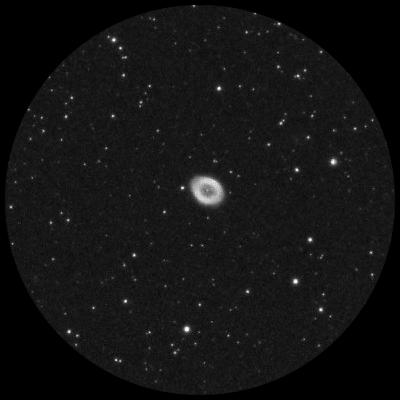
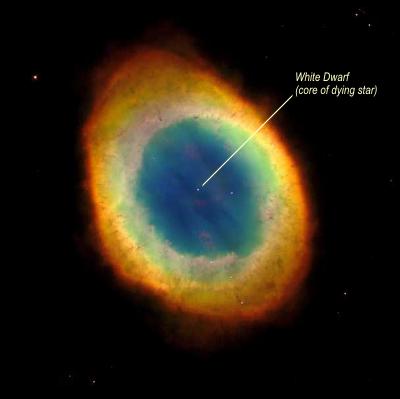
- We can find some more constellations -- some of the best -- by following the
Milky Way down from Lyra to the horizon. Right next to Lyra is Cygnus the Swan.
{Trace out Cygnus}. This constellation is also known as the Northern Cross
and at Christmas time, in the evening, it has rotated across the sky so it is
standing on its base on the northwestern horizon, with the bright star Vega
next to it. Very Christmas-y.
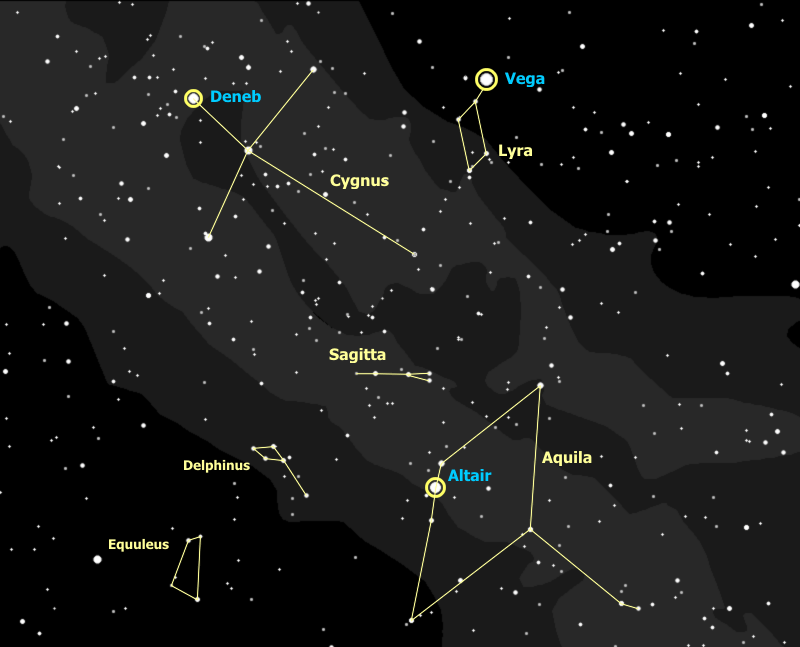
- Deneb is the star at the tail of the Swan. Notice that it's about as bright
as Vega, which is 25 light years away -- so about how far would you guess
Deneb is? As it happens... Deneb is 2500 light years away - 100 times
farther!! Deneb is actually 4,000 times brighter than Vega and 200,000 times
brighter than our sun. If Deneb were as close as Vega, it would be visible
in broad daylight and would cast a shadow at night. This star is one of the
greatest super-giant stars known.
- So what do you think, is Deneb the brightest star in the sky right now?
Do you see any stars you think might be even brighter? Yes, of course,
Vega is considerably brighter than Deneb, mainly because it's closer.
How about Polaris? Which would you say is brighter, Deneb or Polaris?
Astronomers measure star brightness using 'magnitudes' -- Vega has a magnitude of 0, Deneb has a magnitude of 1, and Polaris has a magnitude of 2. As magnitude number goes up, brightness goes down. A magnitude 1 is 2½ times as bright as a magnitude 2, a 2 is 2½ times as bright as a 3, and so on.
This comes from the system set up by ancient Greeks, where the brightest stars were stars of the first magnitude, like 'first class', and the faintest stars you could see were stars of the sixth magnitude. When astronomers got telescopes and instruments that could measure star brightness, they found 1st magnitude stars were almost exactly 100 times the brightness of 6th magnitude stars. That works out to a factor of 2½ from one magnitude to the next.
Magnitudes can go negative for stars brighter than 0 magnitude Vega. Sirius, a winter star in the constellation Canis Major (the Big Dog), is the brightest star anywhere in the sky with a magnitude -1.5.
Well, what's really the brightest star in the sky? The sun has a magnitude of -27.
- Now even though it is a massive super-giant, Deneb is actually a very
young star, at least compared to the sun. Deneb was born only about 3
million years ago, long after the Dinosaurs died out, and is already
approaching the end of its life -- the star can last at most another
million years. Compare this to the life of our sun -- it has been
around for 5 BILLION years, and has another 5 billion left in
it. This is because Deneb is so much more massive than the sun. The
greater mass causes greater pressure and forces the star to burn much
hotter (bluer) and faster. With stars, the bigger they are, the harder
they fall.
- Albireo, the star at the head of the swan, is actually a beautiful double
star, a yellow giant and a blue main-sequence star. You can just split this
star with good binoculars held steady, and it looks better in a telescope.
- The next constellation we reach is Aquila the Eagle. {Trace out Aquila.}
The bright star is Altair, and the two stars on either side of Altair are
called the Pilot Stars. Altair is 16 light years away. It's about half
again as big as our sun and nine times as bright. That shows how sensitive
stars are to mass -- just a little more mass causes the star to burn much
brighter.

The star that is about halfway between Aquila's eastern wingtip and his body is called η (Eta) Aquilae -- and this is a Cepheid variable -- the star itself is unstable and pulsing -- with a cycle of about 7 days. At it's brightest it's nearly as bright as the body star, δ (Delta) Aquilae (actually it's as bright as the eastern Pilot Star β Aquilae), and at it's dimmest it's about as bright as ι (Iota) Aquilae. This is one of only three Cepheids you can see by eye - you will meet δ Cephei, the original, very shortly and the third one is in the winter constellation of Gemini.
- If you look with the binoculars you can find the two stars of Aquila's tail,
then slide west (to the right) until they are at the far left of the field
of view. To the far right of your field of view you can now see a fuzzy
spot with a star at the center - you have found the Wild Duck Cluster. In
a telescope this looks like a dense cluster of tiny stars broken into groups -
the central group is V-shaped and looked to early observers like a flight of
wild ducks - hence the name.
- So you have now been introduced to all three stars of the Summer Triangle:
Vega, Altair, and Deneb. See the triangle? Learning to recognize this
can be a good way to orient yourself in the sky, especially early in the
evening when the stars are first coming out.
- Just above and to the east of Aquila you can spot a small diamond of stars with
a little tail coming down. This is the tiny constellation, Delphinus the Dolphin.
It really looks like a little dolphin, doesn't it?
- Then next to Delphinus, continuing to the left (east) is another teeny tiny,
and faint constellation, Equuleus the Horse. It's four stars forming a horse's
head, with the nose pointing up, to the North. See it? Actually it's five
stars, the corner by his jaw is a pair of stars. Equuleus is nearly the
smallest constellation in the sky -- only the Southern Cross, next to the South
Pole, is smaller.
- The two birds, Aquila the Eagle and Cygnus the Swan, are flying straight at each
other and, to enhance the suspense, Sagitta the Arrow flies between them, just
missing both. {Trace out Sagitta.} What is most interesting about Sagitta,
though, is not so much the constellation as the features for which it is a milestone.
(Note: these two features, technically, are in the neighboring and very faint
constellation "Vulpecula" the Fox.)
If you locate the two tail-feather stars of Sagitta in binoculars then follow the line between them up (to the northwest), just one field of view, you will see the Coathanger, an interesting cluster of stars.
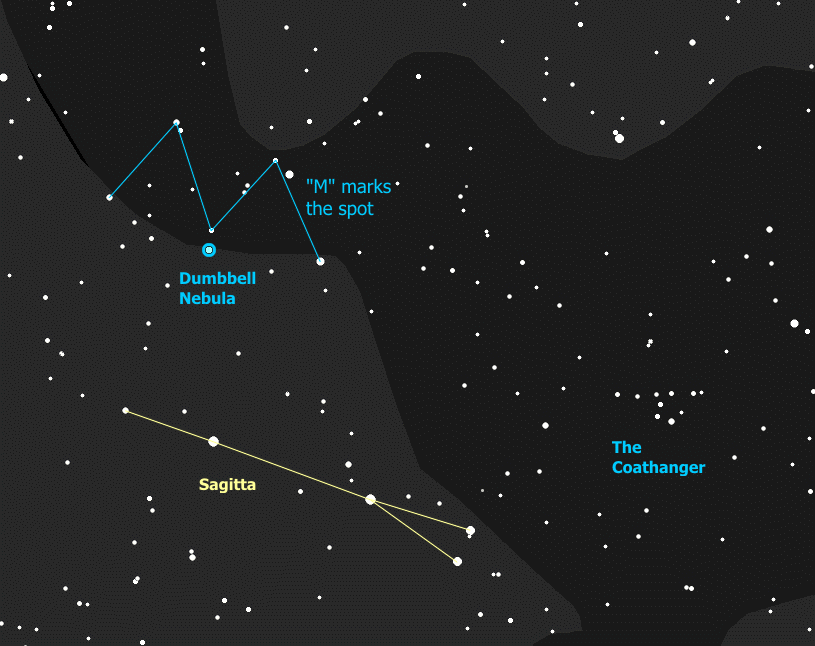
If you are really good with those binoculars you can go up from the tip of the arrow, toward Albireo in Cygnus, and you will find a group of stars that just fill the field of view in the shape of an "M". Right at the central point of the "M" is a faint fuzzy patch that actually is known as the "Dumbbell Nebula". To really see it requires a telescope. This is another planetary nebula - a shell of gas blown off by a dying star, and lit up by the radiation from the exposed core of the star, now a "white dwarf".
 |
 |
 |
| Back to Polar | Go to Autumn Index | On to the Zodiac |
Questions
Your questions and comments regarding the Stargazing section are welcome.
You can e-mail the author, Randy Culp for inquiries,
suggestions, new ideas or just to chat.
Updated 09 August 2020
